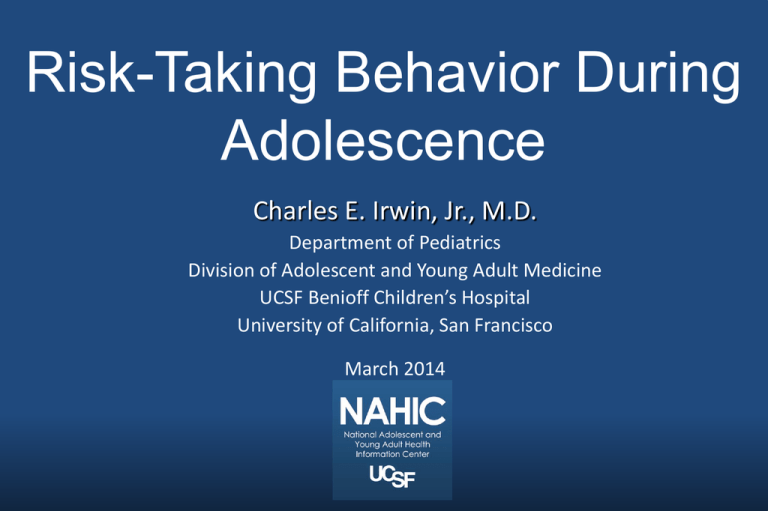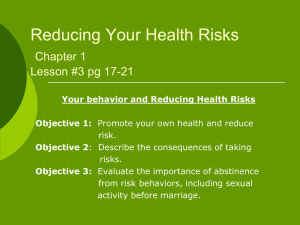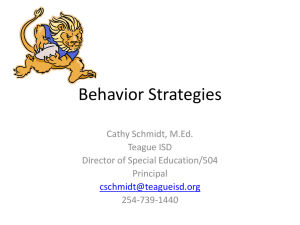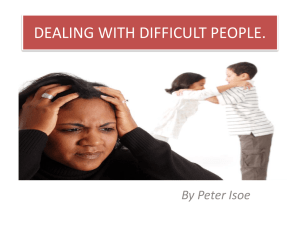
Risk-Taking Behavior During
Adolescence
Charles E. Irwin, Jr., M.D.
Department of Pediatrics
Division of Adolescent and Young Adult Medicine
UCSF Benioff Children’s Hospital
University of California, San Francisco
March 2014
A similar version of this presentation was
presented during Grand Rounds at Children’s
Hospital Boston in October 2009.
Risk Taking – Background
• Majority of morbidity/mortality during
adolescence is preventable
• Behaviors responsible for leading causes of
morbidity/mortality during adulthood in the U.S.
are initiated during second decade of life (e.g.,
smoking, substance use, physical inactivity,
sexual behavior, driving, etc.)
• Co-occurrence of risk behaviors is common
Leading Causes of Death in U.S.:
Ages 10-19 & Ages 25-44, 2010
Source: National Center for Injury Prevention & Control, WISQARS database, 2012
Risk-Taking Behavior
• Volitional
• Potential for Negative Outcome
• Lack of Cognitive Competence regarding
Negative Outcomes
Risky Behaviors
During Adolescence
Specific Behaviors & Outcomes
•
•
•
•
Substance Use: Habituation & Trauma
Sexual Activity: STI’s & Pregnancy
Injury Related Behavior: Trauma & Disability
Eating Behaviors: Eating Disorders, Obesity &
Chronic Physical & Mental Health Disorders
Alcohol Use Among High School
Students, 2011
Source: Youth Risk Behavior Surveillance System, 2011
Cigarette Use Among High School
Students, 2011
Source: Youth Risk Behavior Surveillance System, 2011
Other Tobacco Use Among High
School Students, 2011
Source: Youth Risk Behavior Surveillance System, 2011
Illicit Substance Use Among High
School Students, 2011
Source: Youth Risk Behavior Surveillance System, 2011
Sexual Activity Among High School
Students, 2011
Source: Youth Risk Behavior Surveillance System, 2011
Seatbelt and Helmet Use Among High
School Students, 2011
Source: Youth Risk Behavior Surveillance System, 2011
Driving and Alcohol Use Among High
School Students, 2011
Source: Youth Risk Behavior Surveillance System, 2011
Health Risk Behaviors - Trends
Injury-related behavior
Tobacco use
Unsafe sexual behavior
Alcohol use
Inadequate physical activity
Marijuana use
Poor nutritional habits
Prescription & OTC use
Violence
Arrows denote trends in prevalence over past decade
Covariation of Behaviors
• Injury-related Behavior & Substance Use (e.g.,
Alcohol)
• Substance Use/Substance Use, Sequence &
Developmental Trajectory by Gender
• Sexual Behavior & Substance Use
• Eating Behaviors & Other Risk Behaviors
• Certain Behaviors as Markers (e.g., Sexual Activity,
Substance Use, etc.)
Single & Multiple Risk-Taking Among 7th12th Graders, by Behavior
5%
7%
11%
11%
14%
Source: Urban Institute, 2000, analysis of 1995 Add Health data
Covariation of Risk Behaviors Among
Adolescents (% of Sx, N=1241)
Sexually
Active
Tobacco
Alcohol
Marijuana
Dangerous
Vehicle Use
Sexually
Active
100.0
83.0
88.0
74.2
16.7
Tobacco
44.7
100.0
91.7
66.5
12.8
Alcohol
40.0
77.8
100.0
57.4
12.0
Marijuana
56.2
93.8
95.3
100.0
15.6
Dangerous
Vehicle Use
58.0
82.3
90.8
71.9
100.0
Dangerous vehicle users include subjects who reported driving or riding in
vehicles when the driver is under the influence of alcohol or other substances.
Source: Irwin et. al.. 1998
Distribution of Health Risk Behaviors by
Race/Ethnicity, 7th-12th Grade
Percent Participating
# of Risk
Behaviors
Source: Add Health, 1995
Risk Behaviors in Young People
with Chronic Conditions
• Greater rate of risky behaviours in Swiss youth with chronic
conditions (n=7548)
•
•
•
•
•
•
current smoking
illegal drugs
early sexual debut
eating disorder
antisocial acts
attempted suicide
1.32 (1.13, 1.54)
1.49 (1.15, 1.92)
1.33 (1.03, 1.72)
1.44 (1.26, 1.74)
1.48 (1.26, 1.74)
2.24 (1.55, 3.24)
• Youth with chronic conditions were more likely to report multiple
simultaneous behaviours
Suris et al. Pediatrics 2008
Covariation of Behaviors
Summary of Covariation of Behaviors
•
•
•
•
•
High Prevalence Rate
Early Age of Onset
Gender Specificity
Peers/Family
Behaviors/Not Isolated
Theoretical Models
of Risk-Taking Behavior
Risk Taking as a Dispositional Trait
Risk-Taking Viewed As Deviant & Pathological
•
•
•
•
Poor Self Esteem
Inadequate Social Skills
Propensity for Unconventionality
Problem Behavior Theory
Risk Taking as a Dispositional Trait
Risk-Taking Viewed As Individual Differences
• Sensation Seeking Theories
• Locus of Control
Risk Taking as a Dispositional Trait
Risk-Taking Viewed As Individual Differences
• Sensation Seeking Theories
• Locus of Control
Risk-Taking From an
Ecological Perspective
• Microsystems & Mesosystems: Peers & Parents
• Exosystems: Neighborhoods, Communities, and
the Media
• Macrosystems: The Impact of Culture
Biological Models of Risk-Taking
•
•
•
•
Genetics
Neuroendocrine & Hormonal Influences
Timing of Pubertal Events
Brain development/maturation
Brain Development
• Grey matter volume peaks in early
adolescence
• Selective pruning proceeds ‘from back to
front’
• Greater efficiency of neurotransmission
results from myelination
• Neuromaturation underpins emotional
regulation &control
Biopsychosocial Model
of Risk-Taking
•
•
•
•
•
Dispositional and ecological
Biological development during adolescence
Psychosocial significance of puberty
Psychosocial development
Environmental context
Causal Model of Adolescent
Risk-Taking Behavior
Causal Model of Adolescent Risk-Taking Behavior
Biological Maturation
Cognitive
Scope
Egocentrism
Future time
perspective
Self
Perceptions
Self-esteem
Body image
Self-reliance
Tolerance
Identity
Risk Perception
Optimistic bias
Controllability
Costs
Benefits
Perceptions of Social
Environment
Parental:
Influence
Controls
Supports
Peer:
Influence
Controls
Supports
Personal
Values
interdependence
Affection
Achievement
Characteristics of Peer Group
Peer age, values & behavior
Risk-Taking Behavior
Biopsychosocial
Development
A Model of Development
Early adolescence
10-14 yrs
Puberty heightens
emotional
rousability,
sensation-seeking,
reward orientation
Mid adolescence
15-19 yrs
Period of
heightened
vulnerability to risk
taking, problems in
terms of affect &
behaviour
Late adolescence
20-24 yrs
Maturation of
brain facilitates
regulatory
competence
Steinberg
Adolescent Brain Development
• Brain development
now extends into the
adolescent years
• Most of this
development occurs
in the frontal lobe
- Executive functions
- Planning
- Reasoning
- Impulse control
Physiological Maturation
and Development: Timing
•
•
•
•
Body image
Physical abilities
Sexuality
Hormonal effects
Mechanism of Linkages:
Biology/Behavior Interface
• Maturation (Timing): Environmental pressure
• Early maturing females: Greater risk for
problem behavior/brought in by parents with
complaints of problem behaviors
• Late maturing males: Parents and adolescents
concerned by lack of development, often viewed
as precocious for stage of physical development
Precocious Puberty
("Natural Experiment") Literature
•
•
•
•
•
More behavioral problems
More troubled
Depressed
Aggressive
Decreased social competence
Association of Psychosocial Events with
Physiological Maturation
•
•
•
•
•
Changes in family interactions
Peer relationships and expectations
Patterns of intimacy
Educational achievements
Heterosocial behavior
Specific Examples of Interface of Timing
of Maturation/Development
Early Maturing Females
• More risk/problem behaviors
• "Endomorphic”: Dissatisfaction with
physical development
• Lower self esteem
• Less recognition by same sex peers
• Identity crises
Specific Examples of Interface of
Timing of Maturation/Development
Early Maturing Females, cont.
•
•
•
•
•
Increased needs for independence
Social networks/older adolescents
Environmental pressure
Increase in heterosocial behavior
Early sexual debut
Specific Examples of Interface of
Timing of Maturation/Development
Late Maturing Females
•
•
•
•
Less risk/problem behaviors
Higher self-esteem
More parental/environmental support
Delay in initiation of sexual behavior
Specific Examples of Interface of
Timing of Maturation/Development
Early Maturing Males
• More risk/problem behaviors
• Early sexual debut
Specific Examples of Interface of
Timing of Maturation/Development
Late Maturing Males
•
•
•
•
Less risk/problem behaviors
"Ectomorphic" body type
Negative self-concept and body image
Social disadvantage
Specific Examples of Interface of
Timing of Maturation/Development
Late Maturing Males, cont.
•
•
•
•
•
Less masculine in behavior
More identity crises
More rebellious and impulsive
Expressive and dynamic
More parental/environmental support
Clinical Visit
• General Questions Useful in Assessing the Extent
of Risk Behaviors
• Checklist of Factors for Risk Behaviors
• Health Risk Behaviors and Their Acute and
Chronic Medical Consequences
• Physical Signs in the Risk Behaviors
• Screening Laboratory Tests in Risk Behaviors
Physical Signs with
Risk Behaviors
Recreational/
Skin: Abrasions; Ecchymoses; Lacerations;
motor vehicle use Musculoskeletal—fractures, sprains (acute and
chronic)
Sexual activity
Reproductive skin rash consistent with disease
process; Adenopathy; Amenorrhea; Genital
lesions; Vaginal/penile discharge; Cervical
discharge, edema, friability; Uterine/adnexal
tenderness; Enlarged uterus (pregnant)
HIV = human immuodeficiency virus, STI = sexually transmitted infections
Physical Signs with Risk Behaviors
Substance General: Agitation, anxiety; Decreased general functional status—sleep
use
disturbances, anorexia; Infection with HIV, hepatitis B, other STDs
Skin: Multiple bruises; Track marks; Abscesses
Central nervous system/mental status: Altered mental status; Decreased
short-term memory; Decreased motivation; Decreased fine motor
movements; Diminished coordination
Head, eyes, ears, nose, oropharynx: Injected conjunctivae; Chronic
nasal discharge, nasal mucosal irritation; Recurrent nosebleeds;
Leukoplakia, gingival recession, dental caries; Mucosal inflammation
(nasal passages, oropharynx); Malodorous breath
Breast: Gynecomastia (males)
Cardiorespiratory: Tachycardia; Hypertension; Evidence of
deconditioning; Chronic cough, recurrent bronchitis
Gastrointestinal: Abdominal pain and dyspepsia; Weight loss; Liver
tenderness or enlargement
Musculoskeletal: Poor muscle tone/strength
HIV = human immuodeficiency virus, STI = sexually transmitted infections
Screening Laboratory Tests
in Risk Behaviors
Substance
use
Substance use screen of urine, serum, gastric contents in acute
intoxication, psychiatric symptoms, acute behavior changes
Liver function test-ALT, AST, y-glutaryl transpeptidase (alcohol use)
Hepatitis B – HbsAg, HbsAb, HbcAg (parental drug use)
Human immunodeficiency virus antibody (parenteral drug use)
Sexual
activity
Urine for STI’s (GC, CT)
Cultures and vaginal smears for sexual transmitted infection
Papanicolaou smear
Pregnancy tests
RPR (syphilis)
Human immunodeficiency virus antibody (HIV)
Motor
vehicle/
recreational
vehicle
Substance use screen of urine and blood
General Questions Useful
in Assessing the Extent of
Risk Behaviors
Introduction
• Sometimes young people do things that might be
considered risky, or they take chances.
General Questions
• Do you do anything that you would consider risky or dangerous?
• What kinds of activities do you do?
• How many of your classmates do things that you consider risky
or dangerous?
• What kinds of activities do they do that you think are risky?
• How many of your four closest friends would you say do things
that are risky or dangerous?
• What kinds of activities do they do that you think are risky?
Questions Using Alcohol Use as
an Example
• Have you ever used alcohol? If yes, how often
and how much do you drink? Under what
conditions? With whom?
• When was the last time you had a drink?
• How many of your classmates drink alcohol?
• How about your four closest friends?
• How many of them drink alcohol?
• Do your parents drink?
Questions About Related Behaviors
(For each behavior, ask about frequency,
intensity and situational context)
• Have you ever taken any other drugs?
• Have you ever used alcohol or drugs prior to riding
a bicycle or skateboard?
• Have you ever ridden in a car when the driver had
used alcohol or drugs prior to driving?
• Have you ever driven a car when you had used
alcohol or drugs prior to driving?
• Have you ever had sexual intercourse? (If yes,
query about use of substances prior to sexual
activity)
Anticipatory Guidance
(For each behavior – key messages)
• Avoiding tobacco is very important for your health
• Smoking/Chewing tobacco becomes a habit that is hard to
break
• Avoiding alcohol and drugs is very important for your health
and safety
• Wear a seatbelt every time you ride in a car
• Wear a helmet every time you blade/board/ bike/scooter
• Avoiding sex is the safest way to prevent pregnancy,
STI’s &AIDS.
Checklist of Factors for
Risk Behaviors
Biopsychosocial
• Asynchrony of physiologic/psychosocial
development - early vs. late maturation
• Developmental drives during adolescence – stage
of adolescence
• Attitudes/beliefs
– Sense of competence/invulnerability
– Lack of awareness of consequences
• Male gender
Socioenvironmental
• Peer group known to be engaging in problem behaviors
• Parenting/family style
– Authoritarian/permissive vs. Authoritative
– Chronic family conflict
– Family history of alcoholism/substance abuse
– Lack of cohesiveness
– Parental/family use of substances, incl. cigarettes & alcohol
• Life transitions
• School transitions
• Ready availability of substances, vehicles
Behavioral
• Lack of skills to resist peer pressure
• Sensation-seeking drives
• Personality factors
– Depressive symptomatology
– Anxiety
– Insufficient coping mechanisms
– Poor self-esteem
Intervention and Prevention
Programs: Generalities
• Focus on developmental needs of adolescents
• Focus on physiological development/chronologic
age similarity and disparity
• Critical factors in intervention
Five Principles of Prevention/Intervention
Generic approach
Single behavior as marker
Delay onset of behavior –
anticipatory guidance
Provide alternatives
Insulate from most negative
outcomes
Screening Adolescents for Risky Behavior
Behavior?
Start?
Amount?
Frequency?
Environment?
TOBACCO
Amount?
• How many cigarettes (or snuff) do you usually smoke (or chew) in
a day?
Frequency?
• How often do you smoke/chew tobacco?
Environment?
• Do your friends use tobacco?
• Does anyone in your family or household use tobacco?
TOBACCO
Behavior?
• Do you ever smoke cigarettes or cigars,
or chew tobacco?
Start?
• How long have you been smoking/chewing?
• When was the last time you smoked/chewed tobacco?
• Has a doctor ever told you that you have asthma?
TOBACCO
KEY MESSAGES
Message 1
• Avoiding tobacco is very important for your health
Message 2
• Smoking/Chewing tobacco becomes a habit that is hard to break
Message 3 – for teens who smoke/chew only
• When you decide to stop using tobacco, I can help you and there are
resources to help you
References
Halpern-Felsher BL, Millstein SG, Irwin CE, Jr.: Healthy adolescent psychosocial development. Journal of
Adolescent Health, 31(Supp 6): 216 - 225. 2002.
Irwin CE, Jr.: The Theoretical Concept of At-Risk Adolescents, Adolescent Medicine: State of the Art Reviews, 1:1 14. 1990.
Irwin CE, Jr., Burg SJ, Uhler Cart C,: America’s adolescents: Where have we been, where are we going? Journal of
Adolescent Health, 31;(Supp 6):91 - 121. 2002.
Irwin CE, Jr, Cataldo MF, Matheny AP, Peterson L: Health consequences of behaviors: injury as a model. Pediatrics,
90:798 - 807. 1992.
Irwin CE, Jr., Duncan P; Health Futures of Youth II: Pathways to Adolescent Health. Journal of Adolescent Health,
31;(Supp 6): 82 - 89. 2002.
Irwin CE, Jr., Halpern-Felsher BL: Commentary on Developmental Sources of Crash Risk in Young Drivers. Injury
Prevention 8, Supp II, 21 - 23. 2002.
Irwin CE, Jr., Igra V, Eyre SE, Millstein SG: Risk taking behavior in adolescents: the paradigm. In: Jacobson MS,
Rees JM, Golden NE, Irwin CE, Jr. (eds.), Adolescent Nutritional Disorders: Prevention & Treatment. The Annals
of the New York Academy of Sciences, Vol. 817. New York, NY: The New York Academy of Sciences, pp 1 - 35.
1997.
Irwin CE, Jr., Millstein SG: Biopsychosocial correlates of risk-taking behaviors during adolescence. Journal of
Adolescent Health Care, 7:82S-96S. 1986.
Jessor R. and Jessor SL. Problem behavior and psychological development: A longitudinal study of youth. New York:
Academic Press, 1977.
References
Millstein SG, Irwin CE, Jr., Adler NE, Cohn LD, Kegeles SM, Dolcini MM: Health-risk behaviors and health concerns
among young adolescents. Pediatrics, 89:422 - 428. 1992.
Ozer, EM, Irwin CE, Jr.: Adolescent and Young Adult Health: From Basic Health Status to Clinical Interventions. In:
Lerner RM, Steinberg, Handbook of Adolescent Psychology, 3rdEdition. Hoboken, New Jersey. John Wiley & Sons
pp. 618-641. 2009
Pirkis JE, Irwin CE, Jr., Brindis C, Patton GC, Sawyer MG. Adolescent Substance Use: Beware of International
Comparisons. Journal of Adolescent Health, 33:279 - 286. 2003.
Rivara FP, Park MJ, Irwin CE, Jr.: Trends in Adolescent and Young Adult Morbidity and Mortality. In: Di Clemente RJ,
Santelli J, & Crosby RA (eds.), Adolescent Health: Understanding and Preventing Risk Behaviors. San Francisco:
Jossey-Bass. pp. 7-29. 2009
Sales JA, Irwin CE, Jr.: Theories of Adolescent Risk Taking: The Biopsychosocial Model. In: Di Clemente RJ, Santelli
J, & Crosby RA (eds.), Adolescent Health: Understanding and Preventing Risk Behaviors. San Francisco: JosseyBass. pp. 31-50. 2009.
Steinberg L. Risk taking in Adolescence: New perspectives from the brain and behavioral science. Current Directions
in Psychological Science, 16:55-59. 2007
Steinberg L. Risk taking in adolescence: What changes and why? Annals of the New York Academy of Sciences,
101,51-58. 2004
Tschann JM, Adler NE, Irwin CE, Jr. et al. Initiation of substance use in early adolescence: the role of pubertal timing
and emotional distress. Health Psychology 12(3): 200-08, 1993.
Turner R, Irwin CE, Jr., Millstein SG: Family structure, family processes and experimenting with substances during
adolescence. Journal of Research on Adolescence, 1:93 - 106. 1991.
Screening for Other Behaviors
•
•
•
•
•
•
Alcohol/Drugs
Helmet/Seatbelt Use
Sexual Behavior
Nutrition/Sugared Drinks
Nutrition/Fast Food
Physical Activity
ALCOHOL & DRUGS
Behavior?
• Have you ever drunk alcohol/used drugs?
• What kind of alcohol/drugs do you use?
Start?
• How long have you been using alcohol/drugs?
Amount?
• How much do you usually drink?
• How much (quantify for specific drug) do you usually
use/take/smoke?
• Have you ever had 5 or more drinks of alcohol in a row or engaged
in binge drinking?
ALCOHOL & DRUGS
Frequency?
• How often do you drink/use drugs?
Environment?
• Do any of your friends or family drink alcohol/use
drugs?
• Have you ever been in a car with a driver after he/she
was drinking/using drugs?
• Have you ever driven after drinking/using drugs?
ALCOHOL & DRUGS
KEY MESSAGES
Message 1
• Avoiding alcohol and drugs is very important for your
health and safety
Message 2
• Avoid driving a car, riding a bike, skateboarding,
swimming, boating, riding a scooter, or doing any activity
that is dangerous under the influence of alcohol/drugs or
with someone who is under the influence
HELMET/SEATBELT
Behavior?
• Do you use a seatbelt when riding in/driving a
car?
• Do you wear a helmet when riding/biking/
skateboarding/blading/using a scooter?
Start?
• Have you ever driven/biked/skateboarded/
bladed/scooted after drinking or using drugs
HELMET/SEATBELT
Amount?
• Do you own a helmet?
Frequency?
• How often do you use your seatbelt when riding in a car?
• How often do you wear your helmet when
riding/biking/skateboarding/blading/using a scooter?
Environment?
• Do your friends wear seatbelts?
• Do your friends wear helmets
SEATBELT USE
KEY MESSAGES
Message 1
• Wear a seatbelt every time you ride in a car (for teens
15 ½ and older add: and every time you drive a car)
HELMET USE
KEY MESSAGES
Message 1
• Wear a helmet every time you blade/board/
bike/scooter
Message 2
• If you don’t have a helmet, don’t blade/
board/bike/scooter until you get one
SEXUAL BEHAVIOR
Behavior?
• Have you had vaginal sex? Oral sex? Anal sex?
• Have you had sex with guys, girls, or both?
Start?
• When did you most recently have sex?
• Do you think you or your partner could be pregnant?
• Have you ever been pregnant or had a partner who became pregnant?
• Do you think you or your partner could have a sexually transmitted infection or
STI?
• Have you ever had an STI?
• Has a partner of yours ever had an STI?
SEXUAL BEHAVIOR
Amount?
• Have you had sex with anyone other than your current/most recent partner?
When?
• How many sexual partners have you had?
Frequency?
• How often do you have sex?
Environment?
• Do you use any form of birth control/std prevention when having sex?
• If yes: What type of birth control/STI prevention do you use?
• How often do you use (fill in) method of birth control/std prevention?
• Have you ever felt pressure to have sex?
• Were you using alcohol/drugs when you had sex?
SEXUAL BEHAVIOR
KEY MESSAGES
Message 1
• Avoiding sex is the safest way to prevent pregnancy and sexually
transmitted infections or HIV/AIDS
Message 2
• If you choose to have sex, be responsible:
– Use a condom every time you have sex
– If you don’t have a condom, don’t have sex
– To ensure you don’t get pregnant or get your partner pregnant, and as a
backup to a condom, use another form of birth control such as oral
contraceptives or Depo Provera
– If you have unprotected intercourse, you may obtain emergency
contraception
NUTRITION, SUGARED DRINKS
Behavior?
• Do you drink regular soda/other sweetened beverages/juice?
(examples below)
– Regular soda: Coke, Pepsi, Mountain Dew, 7-up, Sprite, etc. (not
diet soda)
– Other sweetened beverages: lemonade, Hawaiian Punch, Nestea,
Kool-aid, Tampico, Horchata, Sunny-D, etc.
– Juice: all juices, even 100% fruit juices including apple, orange,
grape, cranberry, etc.
NUTRITION, SUGARED DRINKS
Amount?
• When you do drink a regular soda/other sweetened beverage/ juice, how
much do you have? (one cup = 8 oz, 1 can = 12 oz, 1 glass = 12-16 oz, 1
bottle from vending machine = 20 oz)
Frequency?
• How many regular sodas/other sweetened beverages/juices do you drink per
day/week?
Environment?
• Are there sodas/sweetened beverages/juice at home?
• Where else do you get soda/sweetened beverages/juice? (school, corner store,
mall, day care/after school program, etc.)
NUTRITION, FAST FOOD
Behavior?
• Do you ever have fast food? (include going out, drive
through and take-home from McDonald’s, Burger King,
In and Out, Wendy’s, etc.)
Amount?
• When you have fast food, what do you normally order?
NUTRITION, FAST FOOD
Frequency?
• How many times per day/week do you have fast
food?
Environment?
• Do you get fast food with your family/friends?
• Do they serve fast food at school?
• Do you go out for lunch (open campus)?
NUTRITION
KEY MESSAGES
Sugared Beverages
Message 1
• Cutting down on soda, sugared beverages and juice is
important for weight control and health
Additional Message
• Drink water and low fat milk (2%, 1% or fat free) most of
the time (have diet soda, if you must)
NUTRITION
KEY MESSAGES
Fast Food
Message 1
• Limit fast food to no more than once a week
Additional Message
• When you do have fast food, order a smaller sized meal (like
a hamburger instead of a double cheeseburger) and drink
water instead of soda, or diet soda if you must
PHYSICAL ACTIVITY
Behavior?
• What activities or sports do you like to play/do? (include
organized sports such as soccer and basketball, in addition
to unstructured activities like walking to school and
dancing)
Amount?
• Do you do any of those activities or sports for at least 20
minutes until you are breathing heavy and breaking a
sweat?
PHYSICAL ACTIVITY
Frequency?
• How many times per week do you play/practice/do these activities or
sports for at least 20 minutes?
Environment?
• Do you do any activities or sports with your family/friends?
• Is your neighborhood safe to go outside and play?
• Do you have a stationary bike or treadmill at home?
• Do you have PE class at school?
• Is there a neighborhood recreation center where you can go (for
example, YMCA, Boys and Girls club, etc)?
PHYSICAL ACTIVITY
SEDENTARY ACTIVITIES
Behavior?
• Do you watch TV or movies, play video games, or use the computer for fun
(such as games, email, instant messaging)?
Amount?
• How many hours per day are you spending in front of the TV, video, computer
screen?
Frequency?
• Are you doing this every day? Mostly on weekends? During vacation? (to
estimate average daily screen time)
PHYSICAL ACTIVITY
SEDENTARY ACTIVITIES
Environment?
• Do you have a TV in your room?
• Are you eating while watching TV?
• Do you have a VCR/DVD player at home? Can you use it for an
exercise video, like Tae Bo?
• If you have a treadmill/exercise bike, can you put it in front of the
TV so that you can walk/bike while watching?
PHYSICAL ACTIVITY
KEY MESSAGES
Physical and Sedentary Activities
Message 1
• Find an activity/sport that you like and do it every day (goal
is 60 minutes total per day)
Additional Messages
• Cut down on TV, computer and video time (this does not
count homework)
• Remove the TV from the bedroom
• Don’t eat in front of the TV








